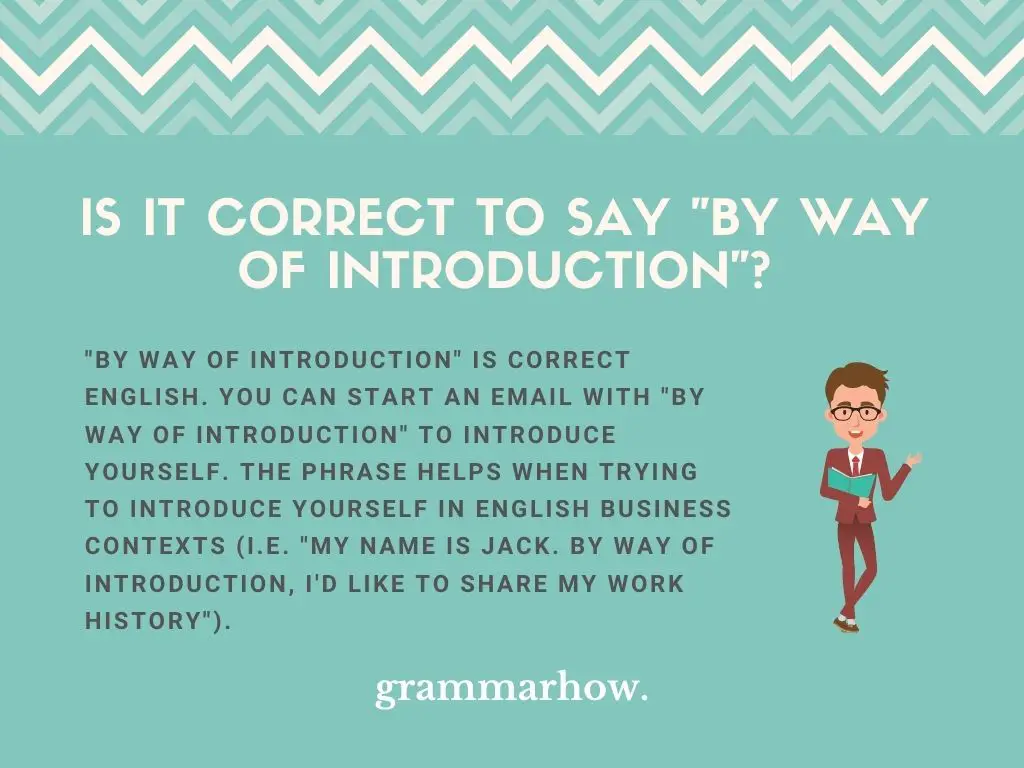Are you confused about the meaning of “by way of introduction” and whether it’s correct? It looks a bit strange when you don’t know much about it. Luckily, this article will help you understand everything there is to know about the phrase.
Is It Correct to Say “By Way of Introduction”?
“By way of introduction” is correct English. You can start an email with “by way of introduction” to introduce yourself. The phrase helps when trying to introduce yourself in English business contexts (i.e. “my name is Jack. By way of introduction, I’d like to share my work history”).

It is grammatically correct, though some argue it’s quite pretentious. It uses too many words to introduce yourself in an email context when fewer words, such as “I am (name),” do the trick.
Still, here is a quick email example showing you how it works:
- Dear all,
- My name is Tony, and I’m your new manager. By way of introduction, I am going to share some new changes with you.
- Kind regards,
- Tony Woodford
“By way of introduction” comes after someone’s name. It becomes an introductory clause in a new sentence, which often introduces something that helps to explain what you expect from people who will work with you.
“By way of introduction” is correct to use, as we have now established. However, you might still be looking for a more suitable alternative in a formal email. We have gathered some suggestions that will help you understand what to say instead of “by way of introduction.”
Other Ways to Say “By Way of Introduction”
Other ways to say “by way of introduction” are “I am,” “let me introduce myself,” and “to introduce myself.” These phrases are great when thinking about how to introduce yourself. They allow you to send an intro email to new coworkers when you have yet to speak to them personally.
1. I Am
“I am” is the simplest example of another way to say “by way of introduction.” You should use it before you include your name or job role. This will let everyone reading the email know what you’re about and what to expect from you.
“I am” uses two words compared to “by way of introduction” using four. This makes it much more concise. It also sounds less braggy and pretentious, making it more ideal when you’re trying to appear polite and respectful.
Phrases like “by way of introduction” are unnecessary in most cases. They are over the top, and most people will judge you for using them.
- Dear all,
- I am Jack, the new head of the department. I’m keen to meet you all over the coming weeks to see how the company works.
- All the best,
- Jack Waters
2. Let Me Introduce Myself
“Let me introduce myself” is a great example of how to say “by way of introduction” personally. “Let me” is a great introductory phrase here because it shows you’re asking for the recipient’s permission. While they can’t give you permission over email, the respect is still made clear here.
“Introduce myself” comes after “let me.” This shows your intention. It lets the readers know you want to introduce yourself to the group by providing something helpful that might apply to you. For example, it could relate to your job role or what you plan on bringing to the table.
- Dear team,
- My name is Maria. Let me introduce myself by inviting you all to a meeting on Friday. I think it’ll be great fun.
- My best,
- Maria Jenkins
3. To Introduce Myself
“To introduce myself” is a great phrase that shows your intention directly. “To introduce” keeps the verb in the infinitive form to let people know what you plan to do in your email. This will give most people a chance to get to know you based on what you say after “to introduce myself.”
As synonyms go, this is a great choice in formal emails. It shows you want to introduce yourself to people directly. Usually, this is done outside of emails, meaning that you’ve set up a plan to see everyone in person.
- Dear team,
- I’m happy to make your acquaintance. To introduce myself, I’d like to invite you all to my office to have a brief meeting.
- All the best,
- Suzie Harrison
4. I Would Like to Introduce Myself
“I would like to introduce myself” is a more polite alternative to the abovementioned one. Including “I would like” at the start of the phrase lets people know you are respectful and polite, which will establish good working communication with them.
“I would like to” is great to include when trying to figure out your place in a formal setting. For example, if you’re a new employee, you should use polite phrases like this to determine whether people appreciate your respectful tone.
Once you’ve figured out your place, you might benefit from dropping “I would like.” In these cases, you can refer back to the previous section mentioning “to introduce myself.”
- Dear colleagues,
- I would like to introduce myself by inviting you out for a business lunch. It would be nice to get to know you all better.
- Kind regards,
- Freddy
5. I’m Pleased to Meet You
“I’m pleased to meet you” is a very polite introductory phrase. You should use it as part of your greeting in a formal email if you want to appear friendly and approachable. It uses a different strategy than the other options, but it’s just as effective in most cases.
“I’m pleased to meet you” doesn’t mention “introductions” at all. Instead, you can use “pleased” to show that you’re happy to be talking to the people on the other side of the email.
This lets them know that you are a nice person and will be good to talk to. It’s a great introduction if you’re trying to come across as down-to-earth (especially if you’re a new boss or manager and want your employees to accept you).
- Dear team,
- My name is Jeffrey. I’m the new acting director. I’m pleased to meet you. I hope we can work in a close capacity.
- Yours,
- Jeffrey Tate
6. As an Introduction
“As an introduction” is a simpler way to introduce yourself than “by way of introduction” which follows similar grammar rules. “As” replaces “By way of,” meaning you don’t need to use as many words when writing this variation in your emails.
“As an introduction” still allows you to provide information relevant to yourself. If it’s the first time you’re talking to the people receiving an email, it might be good to send them some information that will give them a better idea of what to expect from you.
- Dear everyone,
- I’m glad to be sending you this email on my first day. As an introduction, I am attaching a file that tells you more about me.
- All the best,
- Charlotte Winters
7. To Say Hello
“To say hello” works in both formal and informal capacities. It’s less professional than the other forms, but you may use it when greeting a new team and letting them know you’re friendly and happy to work with them.
“Hello” works in place of “introduction” here. You can still provide information relevant to what the recipients might expect from you (i.e. “to say hello, I’ve attached my file”).
“Hello” makes this phrase more informal than the others. This works well in workplaces that don’t depend as much on formal language cues. It’s a great choice when you’re trying to make new friends and get to know your colleagues.
- Dear all,
- I’m just writing this email to say hello. I hope you come to appreciate some of my unique managerial methods.
- All the best,
- Sharon Michaels

Martin holds a Master’s degree in Finance and International Business. He has six years of experience in professional communication with clients, executives, and colleagues. Furthermore, he has teaching experience from Aarhus University. Martin has been featured as an expert in communication and teaching on Forbes and Shopify. Read more about Martin here.
